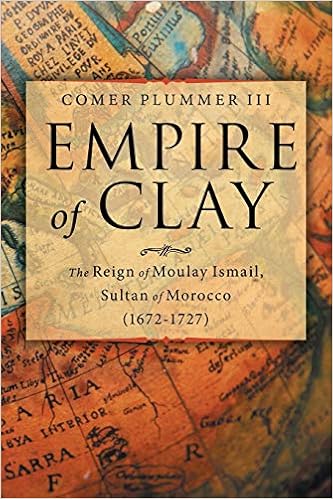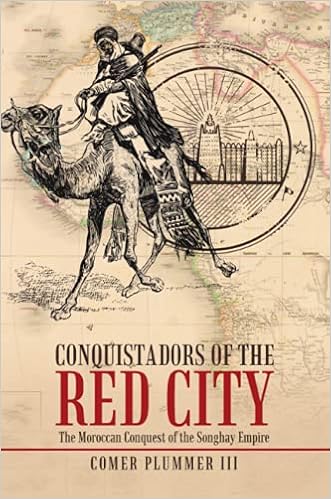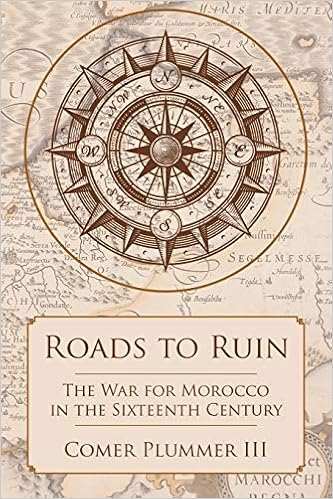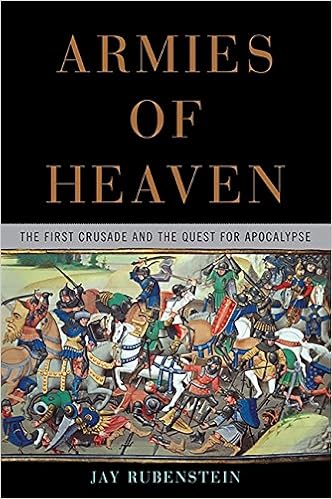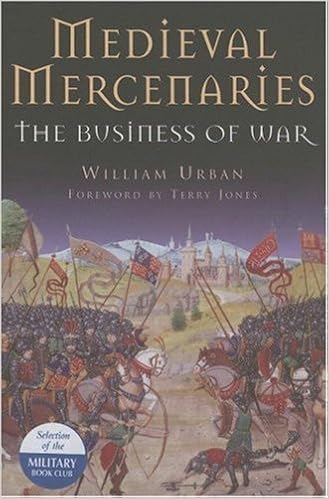The Muslim Horde's Easy Invasion of Iberia
By Robert C. Daniels
After a short foray in July of 710 AD, Muslim forces from North Africa invaded the Christian Iberian Peninsula (modern day Spain and Portugal) in the spring of 711, and within two years, with the exception of the extreme northwestern portion of the peninsula, had successfully overpowered and conquered the Visigothic Christian realms of Iberia.[1] Not only did it take the Frankish forces under Charles Martel to stop the Muslim horde at the battle of Poitiers in 732 from further intrusions into Western Europe, it would take nearly eight centuries for the Iberian Christians to re-take the peninsula from the Muslims. Why were the Muslims able to so quickly invade, conquer, and subdue nearly the entire Iberian Peninsula, whose Christian forces greatly outnumbered the Muslim forces, yet Charles Martel was able to route the Muslims from his land in just one battle?
The Iberian Peninsula had a long and somewhat sordid history prior to the Muslim invasion. Before the coming of the Romans, the peninsula saw several groups of intruders, including Phoenicians, Carthaginians, Greeks, and Celts, all who eventually overlaid the peninsula's original Paleolithic peoples. However, it wasn't until after the Second Punic War (218-201 BC) and the establishment of Iberia as a Roman province that the peninsula began to see any real form of unity.[2]
The ruggedness of the Iberian Peninsula's topography made it a difficult country to move about in. Mountain ranges were plentiful and many of the rivers were not navigable for more than 50 to 100 miles inland. The Romans, however, built their classic stone covered roads connecting all the major cities and areas of the country. As Bernard F. Reilly states, "The prime purpose of this road system was military, i.e., to speed the movement of troops, their supplies and replacements, and the communications essential to their coordination."[3] These roads were destined to be used as such by both the defending Christian armies as well as the invading Muslims.
Christianity came relatively early to the peninsula. By 313, nineteen bishops represented their diocese in Iberia.[4] The next 250 years saw the decline of the Roman Empire on the peninsula and invasions by German Vandals, Alans, and Suevi, which the Romans, in their decline, were taxed to overcome.[5] It was not until another Germanic people, the Visigoths, began to arrive and slowly conquer, subdue, and integrate the various Iberian peoples, and the Arian form of Christianity began to wane in favor of Catholicism that a "distinction between Roman and German would disappear as conquerors and conquered insensibly became one people."[6] For the next one and a half centuries, the Visigothic Kings expanded and consolidated their kingdoms, and the Catholic Church became the dominant religion over the Arian Church for the Christians among the Iberians, although Arianism itself never totally vanished.
However, besides the two Christian religious sects, which continued quarreling from time to time, there also existed a large Jewish population on the peninsula, and "If the Catholics could not tolerate Arians they were unlikely to pass over the long-standing religious competition of the Jews."[7] The situation for the Jews became especially grim in 612 when Sisebut I came to the Visigothic throne (612-621).[8]
Four years into his reign, in 616, Sisebut I declared that any Jew refusing to be baptized would "be given one hundred lashes and, if he still proved stubborn, he was to be banished and all his property confiscated."[9] While an estimated 90,000 Iberian Jews chose to convert to Christianity, it is, however, thought that many of these continued to lead Jewish lives; others fled to North Africa to join their Jewish brothers across the Strait of Gibraltar, many of whom were Berbers of the Atlas Mountains who had earlier converted to Judaism.[10]
After the collapse of an attempted Jewish revolt against their Iberian Visigothic rulers in 694, according to Elmer Bendiner, the Iberian Jewish "goods were declared confiscated" and the Jews themselves were henceforth to be enslaved. In addition, Jewish sons were to be given to Christian slave-masters to be raised and married as Catholics. However, as Bendiner continues, "what was thundered in Toledo echoed only faintly beyond the walls of the city. Some Jews died and some were converted and some lost their children, but most went on with their farm work and their marketing."[11]
Along with the strengthening of Catholicism among the Iberian peoples came the increase in land owned by the Church, and those people living on the Church's land became essentially indentured to the land, hence they became indentured to the Church. The Third Council of Toledo "reaffirmed that the bishop was the sole legal proprietor of all church property of the diocese," and with the dominion over the land also went dominion over the people living on the land, whether Christian, Arian, or Jew. This same council also "mandated that even freedmen, formerly slaves of the church, should continue subject to its legal tutelage," thereby giving the bishops what amounted to a kingly rule over the people who lived on the church's property.[12]
Besides the Church's property, the Iberian Peninsula also contained many large rural estates. These estates came to be ruled by magnates whose authority grew as time passed; many eventually taking titles of nobility. To protect these estates against freedmen and runaway slaves, who, due to extreme poverty, were forced into banditry, the magnates transformed the estates into walled fortresses. Although the magnates were subjects of the crown, they were more often than not local figures, had nearly unhindered power over their own realms—similar to the authority the bishops had over the church's property—and possessed and personally led their own armies of retainers. As Helen Nicholson states, "The core of the medieval army was always the leader's personal troops: the personal warband or comitatus. "[13] Archer Jones writes that the armies were "small professional forces supplemented by untrained and ill-armed militia. They stressed shock action, with neither light cavalry nor light infantry playing much role."[14] Like the magnates, the king's standing army, unless his magnates and their retainers were summoned, consisted only of his own royal bodyguards.[15]
Although the Iberian Peninsula under the Visigoths was ruled by a king, the kings were elected by councils. This tended to lead to crisis of successions occurring nearly every time a king died. As Bendiner states, "Sometimes the king named a successor, but that choice was not always honored. Often the old king was shuffled off his throne to death or dishonor before he could pronounce the name of his successor."[16]
Quarrels soon became common among the bishops and the magnates, each vying for more power, land, and authority. These quarrels, however, were not only limited to just between the Bishops and the Magnates. Many of the magnates wanted to shed the title of mere magnate or even noble for the title of a fully autonomous king, and bishops routinely chose sides in these quarrels and uprisings for political reasons. Subsequently, quarrels between the magnates, bishops, and the reigning king also became common. This led to many of the kings, on a nearly routine basis, having to forcibly put down rebellions. As Bendiner states, "Rebel nobles, when captured, were routinely tortured, blinded or put to death. Bishops conspired with this faction or that, and some went to their deaths in small partisan causes that loomed great for a season."[17]
Many of the kings themselves also tended to alienate their subject magnates and bishops. As Bendiner relates, the time honored-way for a newly elected king to act was by "raging in the customary and bloody manner appropriate to the first year of a new administration"[18] and "killing or banishing the friends of his predecessor."[19] Antonio Santosuosso confirms this when he writes that "each ruler tended to reward those who had supported him and to punish those who had not."[20]
All of these animosities began to take their effect, and the crown eventually became so progressively weak and its inability to project its power far beyond the king's own presence became so great that the king "could hardly compel obedience against the magnates and was hard put to purchase it."[21] As Santosuosso puts it, "The Kingdom of Toledo had experienced in the forty years before the [Muslim] invasion a series of rebellions and upheavals that resulted in the disintegration of central authority and misgovernment at every level" resulting in the sovereigns not being able to rely on the aristocracy when they needed them.[22] Therefore, when the need to defend the royal realm from invaders occurred, the king had to "rule by the force of his personality, the excess of his talent, the diplomatic skill to divide his opponents, and the charisma of his office"[23] if he could even gather enough forces to oppose the invaders.
By 711, with the many separate enclaves, the proprietor—whether a bishop, a magnate, or the actual king—being essentially his own king with virtually unlimited power within his own small realm, along with the alienated peasants, slaves, and persecuted Jews, the Iberian Peninsula was ripe for invasion from an organized outside force.
In fact, by 711 the peninsula was politically separated into two kingdoms. King Witza (703-710) had just died the year before. He had designated his son Agila (710-714) as his successor, which was the fourth king in succession from the same family—the making of a dynasty. This troubled many of the nobles, who instead chose Rodrigo (710-711) to be their king, effectively cutting the kingdom in two.[24]
Although Rodrigo was elected king by many of the nobles, many other nobles considered him "illegitimate, for he had wrested the throne from the King."[25] As Santosuosso puts it, "this meant that the aristocratic bloc, upon which rested the military strength of the state, was never a monolithic entity but fragmented into factions," and "Most soldiers of the Visigothic army were intent only on dethroning Rodrigo…and on replacing his faction."[26]
By 710, the Muslim conquest of North Africa had reached the North African Atlantic coast. Musa ibn Nusair (also spelled Musa ibn Nasayr), the Muslim governor of northern Africa, had in his employ a large Berber (also commonly referred to as Moors) army. As J.F.C. Fuller states, the Berbers were "Plunderers by nature," and "in order to keep them employed,…Nusair…turned his gaze toward Spain."[27] For assistance Nusair looked to Julian, the Byzantine governor of Ceuta. Julian, also known in various transcriptions from Arabic as Yulyan, Urban, and Olman,[28] had been able to maintain his position as governor of Ceuta over the years "by dealing, not warring, with those at his gates," whether those at his gates were Visigoths, Byzantines, or North African tribesmen.[29] Nusair and the Muslims were no exception, and Julian, having a grudge against Rodrigo for dishonoring Julian's daughter, was more than willing to help Nusair invade King Rodrigo's realm by supplying Nusair with four ships to ferry troops across the strait.[30]
Upon obtaining permission from the Muslim Caliph in Damascus, Nusair sent Abu Zora Tarif with 400 men across the strait in Julian's ships during the summer of 710.[31] According to Bendiner, this Muslim force consisted of "three hundred foot soldiers and one hundred horsemen with their mounts," and on a July morning landed on a peninsula that is still today called Tarifa.[32] "The booty picked up in this brief excursion seems to have been highly satisfactory, although the only items recorded by historians are some very attractive girls who were carried home by the invaders."[33]
This foray greatly encouraged Nusair, who then sent an extended expedition of 7,000 Muslim troops the next year (711) under the command of the governor of Tangier, Tarik ibn Ziyad, in 400-man batches, which is all that Julian's four ships could carry at one time.[34] According to Bendiner, this took place in either April or May of 711 (historians are not sure which month is correct).[35] With the Caliph only having given Nusair "a very cautious go-ahead for [only] a reconnaissance expedition to probe the Visigothic defenses,"[36] Nusair's plan was not for a full invasion, but a limited reconnaissance. However, after setting up a supply base at what would become the port of Algeciras and putting Julian in charge of this camp, Ziyad advanced his small army inland.[37]
King Rodrigo at the time, as Reilly puts it, was "apparently engaged in one of those punitive expeditions against the Basques of the north which had been the periodic necessity of every Visigothic monarch since the sixth century."[38] Bendiner lists Pamplona as the rebellious city Rodrigo was subduing,[39] while Fuller states that "Roderic [as Fuller calls Rodrigo] was engaged in a war with the Franks and Vascons in the north of Spain."[40] Regardless of which faction Rodrigo was fighting against in the north, the fact remains that he was in the northern regions of his realm struggling against other European Christians for his reign's survival when the southern part of his kingdom was invaded by Arabic Muslims from North Africa. Upon hearing of this new intrusion, Rodrigo hastened south to stem the assault, briefly stopping at Cordoba to gather what forces he could.
Ziyad in turn dug in along the cost and sent for reinforcements. With the 5,000 Berber reinforcements Nusair sent, along with the 7,000-man force originally sent over, Ziyad had an array of some 12,000 troops. As Bendiner reports, this Muslim force was also added to by
| a handful of Visigothic exiles each seeking his own revenge. Allies began to flock into the camp. These included many of the discontented in Spain, but principally the Jews, who had been expecting and praying for such a deliverance. Now they offered to fight for it and some of them sparked local uprisings to pave the way for the Muslims.[41] |
Thereby, Ziyad commanded a formidable force, as well as obtaining allies local to the Iberian Peninsula who knew both the Visigothic form of fighting and the countryside.
On the other hand, Rodrigo commanded an army whose supporting wings "were commanded by men who envied or loathed their king. The rank-and-file consisted of proxies by unenthusiastic landholders."[42] According to Santosuosso, these two commanders were "Sisberto and Oppa, brothers, not sons as the Arab chronicles maintain, of the former king Witiza [as Santosuosso calls Witza]."[43]
Years of Visigothic noble infighting had taken their toll, and as Bendiner relates, the officers of the supporting wings, "confident that the invaders wanted nothing more than booty, hoped that they would take Roderick [as Bendiner refers to Rodrigo] along with greater treasures, leaving the throne up for grabs."[44] Santosuosso confirms this when he states that Rodrigo's forces outnumbered Ziyad's by 2.4 to 1, "But the royal host's numerical superiority hid many traps….Many [of Rodrigo's] aristocrats hoped that the Muslims would sweep aside the usurping king and then quickly return to North Africa with their loot."[45]
As a result, when the battle ensued, "Many of the disaffected Visigothic nobles broke and ran as the first Berber or Jew stood his ground."[46] Fuller confirms this betrayal by the Visigothic nobles when he states that Ziyad "met Roderic [as Fuller calls Rodrigo] in the Valley of the Wadi Bekka (Salado), between Lake Janda and the town of Medina Sidonia, and thanks to treachery in Roderic's army, on July 19 he routed him."[47] According to Santosuosso, "The center led by the king fought well. It was the wings, where the supporters of the former king stood, that the Visigothic host lost the battle.[48] Santosuosso furthers that
| It was probably not due to outright betrayal, and there is no reason to assume that Witiza's supporters passed to the Muslims during the encounter, although it is reasonable to say that their heart may not have been in the fight. Certainly they were the first to flee.[49] |
Rodrigo vanishes from history at this point, and as Bendiner adds, "No one knows whether he died in battle or went into hiding."[50]
After defeating Rodrigo at Salado, Ziyad ventured north, and after winning another battle at Ecija he headed for Toledo, the Visigothic capital. On the way, he captured Cordoba. According to Reilly, Ziyad "found the city undefended and took it; arriving thence in Toledo he found that city also in disorder and similarly at his mercy."[51] Bendiner, however, states that Ziyad "dispatched a lieutenant with seven hundred horsemen to capture Cordoba. That the city held out for three months and was finally taken only with the help of impatient Jews and dissident Christians within the walls."[52] Bendiner also states that Ziyad's "advance guard was made up of Jews and Christians who had gone over to the invaders. The Christians were probably serfs who would eagerly join in the hosannahs to liberation."[53]
Toledo, as stated, also easily fell to Ziyad. Without a reigning king, and with the nobles unable to unite due to their continued infighting, little if any organized resistance was met by Ziyad after the battle of Ecija. As Bendiner aptly states concerning Toledo, "Long before the [Muslim led] army reached the city the archbishop of Spain, Sindared, packed and left for Rome. When the primate was gone the assembled dukes, duchesses, generals, lieutenants, garrison and townspeople took to the hills in panic."[54]
With the fall of Toledo and the dispersement of the noble elite and their forces, the rest of the Iberian Peninsula was ripe for an easy conquest by the Muslim forces. This was accomplished over the next couple of years beginning with the arrival of Nusair in Spain with additional forces who, after first conducting a separate foray, joined forces with his lieutenant Ziyad. By the end of 713 they had conquered, at least temporarily, all of the Iberian Peninsula with the exception of the Basque regions. Those Christian nobles of the northern regions who were able to maintain or regain their realms reverted to raids into al-Andalus or, more commonly, Andalusia, as the Muslims called their conquered areas of the Iberian Peninsula,[55] as well as defending their lands from Muslim raids. As Nicholson states:
| It was not that the war was pressed continuously. There were truces, diplomatic contacts, occasional conversions, and Christian and Muslims crossed the border for peaceful as well as martial purposes. But the rulers of neither side wanted long-term peace.[56] |
In just two years, the combined and relatively organized Muslim armies, aided by disaffected Christian nobles and alienated Christian serfs alike, as well as persecuted Jews and slaves, conquered the Iberian Peninsula. To help maintain cohesion and establish a peaceful transformation from Christian to Muslim rule, Nusair, unlike his Christian predecessors, "immediately set about organizing Spain with delicate tact."[57] He lightened taxes, did not seize property, and allowed the cohabitation of faiths. This meant that the Jewish population, which quickly began to increase as those that had fled to North Africa began to return, was free to live as equals, as long as they paid their infidel poll tax—the Christians, also being infidels, were expected to pay this same poll tax as well. As Bendiner states, "Never had the Jews known such toleration since the Romans abandoned their pantheon."[58] Therefore, the Jewish population of Andalusia not only became endeared to their Muslim rulers, but wholeheartedly supported them. Nusair even used them to garrison the cities he had taken while he and his Arab cavalry made their advance through the peninsula.[59]
Along with the Jewish population, many of the Christians of the peninsula were also able to prosper over the next centuries under Muslim rule as well. The Muslim rulers allowed many of the magnates, nobles, and even some of the bishops to maintain their personal realms and worship as they pleased as long as they paid the appropriate taxes. Many of the "Christian population [even] came to be so-called [Mozarabs] because they gradually adopted the dress, some of the diet of the Muslims, and even achieved some degree of bi-lingualism in Arabic."[60] All in all, the non-Muslim community of Andalusia quickly became, for the most part, content with their new situation and found little reason to resist or revolt against it, leaving the Muslims free to further their conquests.
Once control was implemented over the vast majority of the Iberian Peninsula, the Muslims began venturing over the Pyrenees into what would become southern France. The Franks, however, unlike their Iberian Visigothic neighbors to the south, were much better organized and were led by a charismatic leader who was able to unite the countryside against the invaders and defeat the Muslim forces in one major battle, stemming the northern expansion of Islam in Western Europe. As George Holms writes:
| The Islamic inroads were checked by the famous victory of Charles Martel, the Frankish mayor of the palace, at Poitiers in 732, and the subsequent Frankish reoccupation of southern France formed a potent barrier to further Arab expansion by land.[61] |
Martel's army, at the Battle of Poitiers, for the most part, consisted of the same type and style of forces that the Iberian Visigothic army consisted of: mounted and dismounted knights (heavy cavalry and heavy infantry) armed with lance and sword. As Jones states:
| The cavalryman also had the skill and inclination to fight on foot as well as mounted. Where the terrain or the besieging of fortifications, for example, made infantry essential, the Western professional soldier displayed a readiness and willingness to fight skillfully on foot, but he fought in the same way, as an individual rather than a part of a formation.[62] |
Nicholson states that "Charles drew up his [dismounted] forces on foot in a dense phalanx….The Frank's ranks remained unmoving before the enemy's attack, ‘like a wall'…according to the anonymous Spanish chronicler of the battle."[63]
In contrast, the Muslim army in both the Iberian Peninsula and in Southern France, according to Nicholson, "made much use of horse-archers,"[64] which relates to light cavalry armed with bows and arrows. Nicholson also states that at times, such as at the battle of Poitiers, the Muslim horse-archers also fought dismounted with their bow as light infantry.[65] However, Jones hints that the Muslims also used heavy cavalry when he states that the Muslim "shock cavalry failed against the combined forces of the Frankish infantry, and the dismounted Frankish Cavalry."[66]
Whether fighting as mounted or dismounted archers, the use of the horse by the Muslims and the influence it had on the continent is confirmed by Maurice Keen, who relates:
| The Islamic conquests of Iberia…had, after all, brought superior oriental breeds and an advanced equestrian culture to the attention of the West. The Moors introduced to Spain the Barb, the Turkmene, and the Arabian, and made full use of the indigenous breeds, including the Andalusian.[67] |
The rapid loss of the Iberian Peninsula was not due to inferior fighting forces on the part of the Iberian Visigothic armies. Martel's Frankish army consisted of the same type and style of forces that the Iberian Visigothic armies consisted of. They both also fought in the same manner. In addition, the Muslim forces opposing both Christian armies consisted of and utilized the same type of offensive forces and action against both of the Christian armies. The Iberian Visigothic forces also outnumbered those of the Muslims, sometimes, as we have seen, as much as 2.4 to 1. What caused the Iberian Visigothic forces' defeat against the Muslims was the disunity between the Iberian Visigothic forces. Martel was able to summon a large, united Frankish force, and through his strong personal charisma, effectively lead it to victory. Rodrigo, on the other hand, due to his alienation of many of the nobles, bishops, peasants, and slaves, along with the ever increasing persecution of the Jews, was unable to use what charisma he possessed to even gather a loyal enough army, much less lead it to defeat the invading Muslims.
As Santosuosso writes of the state of affairs in Iberia at the time of the Muslim invasion:
| The aristocrats were ready to betray the loyalty that they had sworn to the crown; the kings were unable to check the rapacious policies of their tax collectors and the nobility; the most powerful clergymen made a mockery of their vows of chastity and obedience to the precepts of Christ. It was a condition that called for disintegration of central power or for the reception of any benevolent invader who promised a better world.[68] |
According to Pedro Chalmeta, it was "a deep crisis that affected the efficacy and stability of its political, military, juridical, ecclesiastical, economical, and social structures"[69] that caused the Muslims to easily ride over the Iberian Visigothic army, and as Holms adds, "Factors such as succession problems and the alienation of the Jewish minority played their part."[70] In fact, Musa ibn Nusair fell into a nearly already conquered land when he sent Abu Zora Tarif to the southern shore of the Iberian Peninsula. He did not have to divide and conquer his foe, as the age-old maxim goes, they were already divided. Charles Martel, on the other hand, was able to handily defeat the Muslim horde swarming into southern France from the conquered Iberia because his led a united and loyal force.
| * * * |
Show Notes
| * * * |
© 2025 Robert C. Daniels.
About the author:
Robert C. Daniels, a retired U.S. Navy Chief Petty Officer, holds a BA in History from Old Dominion University (ODU), Norfolk, VA, and a MA in Military Studies, Land Warfare from the American Military University (AMU), Manassas Park, VA. He has written and published two books telling the exploits of both WWII era veterans and civilians: 1220 Days and World War II in Mid-America and several military history articles published on https://www.militaryhistoryonline.com. He currently is writing a book about the Black Hawk War, and teaches U.S. History, World Civilization History, and Western Civilization History at Tidewater Community College in Virginia Beach, VA, as an adjunct professor. https://www.robertcdaniels.com
* Views expressed by contributors are their own and do not necessarily represent those of MilitaryHistoryOnline.com.

